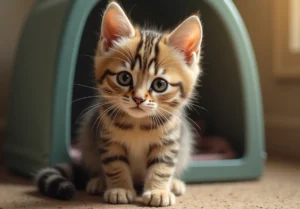Cats have been banned in a part of Norway – but why? Here’s the scoop on this fascinating topic:
Cats in Norway: The Ban Explained
The History of the Ban
In a small part of Norway, a unique ban on cats has been in place for decades. This prohibition can be traced back to the early 1900s when the local government decided to implement measures to protect native bird species and wildlife in the area. Due to the predatory nature of cats, which can pose a threat to vulnerable bird populations, the ban was put in place as a conservation effort to maintain ecological balance.
Interestingly, this ban has been a subject of debate and intrigue among locals and conservationists alike. While some argue that the ban is necessary to protect the delicate ecosystem of the region, others question the effectiveness and fairness of targeting cats specifically. The history of this ban sheds light on the complex relationship between human activity and environmental preservation in the modern world.
Environmental Impact
The decision to ban cats in this part of Norway was not taken lightly, as it was based on the potential devastating consequences their presence could have on the local ecosystem. Cats, being skilled hunters, pose a significant threat to native bird populations and other wildlife in the area. Their predatory behavior can disrupt the balance of the ecosystem, leading to a decline in biodiversity and potentially endangering certain species.
Moreover, the ban serves as a proactive measure to prevent the negative impact of invasive species on the fragile environment of the region. By restricting the presence of cats, the local authorities aim to protect the natural habitats and ensure the sustainability of the local flora and fauna. This decision reflects a commitment to responsible environmental stewardship and the preservation of biodiversity.
- Unique Insight: Additionally, the ban on cats highlights the importance of local communities in conservation efforts. By involving residents in the protection of the environment, a sense of ownership and responsibility is fostered, leading to sustainable conservation practices.
Remember, when exploring the reasons behind the ban on cats in this part of Norway, it’s essential to consider the ecological significance and the long-term consequences of human actions on the natural world. By understanding the environmental impact of invasive species, we can work towards creating a harmonious relationship between humans and wildlife.
Alternative Solutions
When it comes to addressing the issues caused by cats in a part of Norway, alternative solutions have been proposed to mitigate the impact of these feline friends. One suggestion is the implementation of stricter regulations on pet ownership, including mandatory spaying and neutering of cats to control population growth. Additionally, promoting responsible pet ownership through education and awareness campaigns can help prevent cats from roaming freely and causing environmental disruption. Encouraging the use of cat containment systems, such as outdoor enclosures or catios, can also help limit the negative effects of cats on local wildlife. By exploring these alternative solutions, the community can work towards finding a balance between cat ownership and conservation efforts in the area.
Public Opinion
Have you ever wondered how the local community feels about the ban on cats in a part of Norway? Public opinion on this issue is divided, with some residents supporting the ban as a necessary measure to protect native wildlife from predation by cats. On the other hand, there are those who oppose the ban, citing concerns about interference with personal freedoms and pet ownership rights. While some believe that the ban is a step in the right direction for environmental conservation, others argue that it may not be the most effective solution to the problem. By listening to the diverse perspectives within the community, it becomes apparent that finding a balance between animal welfare and wildlife protection is essential for addressing this complex issue.
Legal Ramifications
Let’s dive into the legal aspects surrounding the ban on owning cats in a specific region of Norway. It all comes down to protecting the native wildlife, especially bird populations. Cats are known to be skilled hunters, posing a threat to vulnerable species. The ban aims to preserve the local ecosystem and maintain a balance in the environment. If caught owning a cat in the restricted area, individuals may face fines or other legal consequences. It’s crucial to respect this regulation to safeguard the delicate ecological harmony in the region.
Future Outlook
As cat owners in this part of Norway, it’s essential to adapt to the ban and explore alternative ways to enjoy the companionship of pets while respecting the local laws. Consider supporting initiatives that promote responsible pet ownership and conservation efforts. Keep an eye out for potential changes to the ban, as authorities may review policies based on feedback and research. Engage in constructive dialogues with community leaders to advocate for sustainable solutions that benefit both animal welfare and biodiversity. By staying informed and proactive, cat owners can contribute positively to the evolving landscape of pet regulations.
Unique Wildlife
Norway is home to a diverse range of unique wildlife, including species like the Arctic fox, reindeer, and several bird species that are crucial to the delicate ecosystem of the region. These animals have adapted to survive in the harsh Arctic environment, playing key roles in maintaining the balance of the ecosystem. Protecting these species is vital to preserving the biodiversity and natural beauty of Norway.
Here are some important species in the region:
– Arctic Fox: Known for its pristine white fur, the Arctic fox is a symbol of resilience in the face of extreme cold weather conditions. Their presence in the ecosystem helps control small mammal populations.
– Reindeer: These iconic animals are not only culturally significant in Norway but also play a crucial role in shaping the landscape through grazing habits, making them essential to the ecosystem.
– Bird Species: Norway is a haven for various bird species, such as puffins and sea eagles, which contribute to seed dispersal and pest control, maintaining the health of the local flora and fauna.
Understanding the importance of protecting these unique species sheds light on why the ban on cats is in place – to prevent them from endangering the delicate balance of the ecosystem by hunting native wildlife.
Cultural Perspectives
In Norway, cats are banned in a specific region to protect the native wildlife and uphold cultural values deeply rooted in Norwegian society. Cats, as natural predators, pose a threat to the fragile balance of the ecosystem by hunting local bird and mammal species. This ban reflects Norway’s commitment to preserving its natural heritage and respecting the interconnectedness of all living beings.
Norwegian culture places a strong emphasis on environmental conservation and harmonious coexistence with nature. The ban on cats serves as a tangible manifestation of these values, highlighting the importance of responsible pet ownership and environmental stewardship. By adhering to this ban, Norwegians demonstrate their respect for the unique wildlife that defines their country’s identity.
By understanding the cultural significance of this ban, we gain insight into the deep-rooted respect for nature and wildlife that permeates Norwegian society. It serves as a reminder of the interconnectedness of all living beings and the necessity of protecting our planet for future generations.
Interesting Facts
Cats and Biodiversity : Did you know that cats, especially feral ones, can have a significant impact on local ecosystems? In some parts of the world, cats have been known to hunt and disrupt local wildlife populations, leading to a decline in biodiversity.
Norwegian Regulation : In Norway, specifically on the island of Svalbard, cats are banned to protect the delicate Arctic environment. The ban aims to prevent cats from preying on native bird species, which are crucial to the island’s ecosystem.
Global Efforts : Norway’s decision to ban cats in certain areas reflects a growing awareness of the importance of preserving biodiversity and protecting vulnerable ecosystems. Similar measures have been taken in other parts of the world to mitigate the impact of feral cats on wildlife.
Cat Owners’ Responsibility : While domestic cats can make loving companions, it’s essential for cat owners to be mindful of their pets’ potential impact on the environment. By keeping cats indoors or monitoring their outdoor activities, owners can help protect local wildlife while enjoying the company of their feline friends.
Unique Insight : As responsible pet owners, it’s crucial to be aware of the impact our furry companions can have on the environment. By taking simple precautions, such as keeping cats indoors or on leashes, we can help preserve the delicate balance of ecosystems worldwide.
Impact on Local Wildlife
Predator-Prey Relationship : Cats are natural predators, and when left to roam freely in the wild, they can have a devastating impact on local wildlife populations.
Decline in Bird Species : Birds are particularly vulnerable to cat predation, leading to a decline in bird populations in areas where feral cats roam unchecked.
Ecosystem Disruption : By disrupting natural predator-prey relationships, cats can have cascading effects on entire ecosystems, affecting plants, insects, and other animals in the food chain.
Conservation Efforts : Banning cats in specific areas, like on the island of Svalbard in Norway, is one way to protect native wildlife and promote conservation efforts for the preservation of fragile ecosystems.
Remember, as much as we love our feline friends, it’s essential to consider their impact on the environment and take measures to protect local wildlife.
Alex, a passionate animal lover, has experience in training and understanding animal behavior. As a proud pet parent to two dogs and three cats, he founded AnimalReport.net to share insights from animal experts and expand his knowledge of the animal kingdom.




